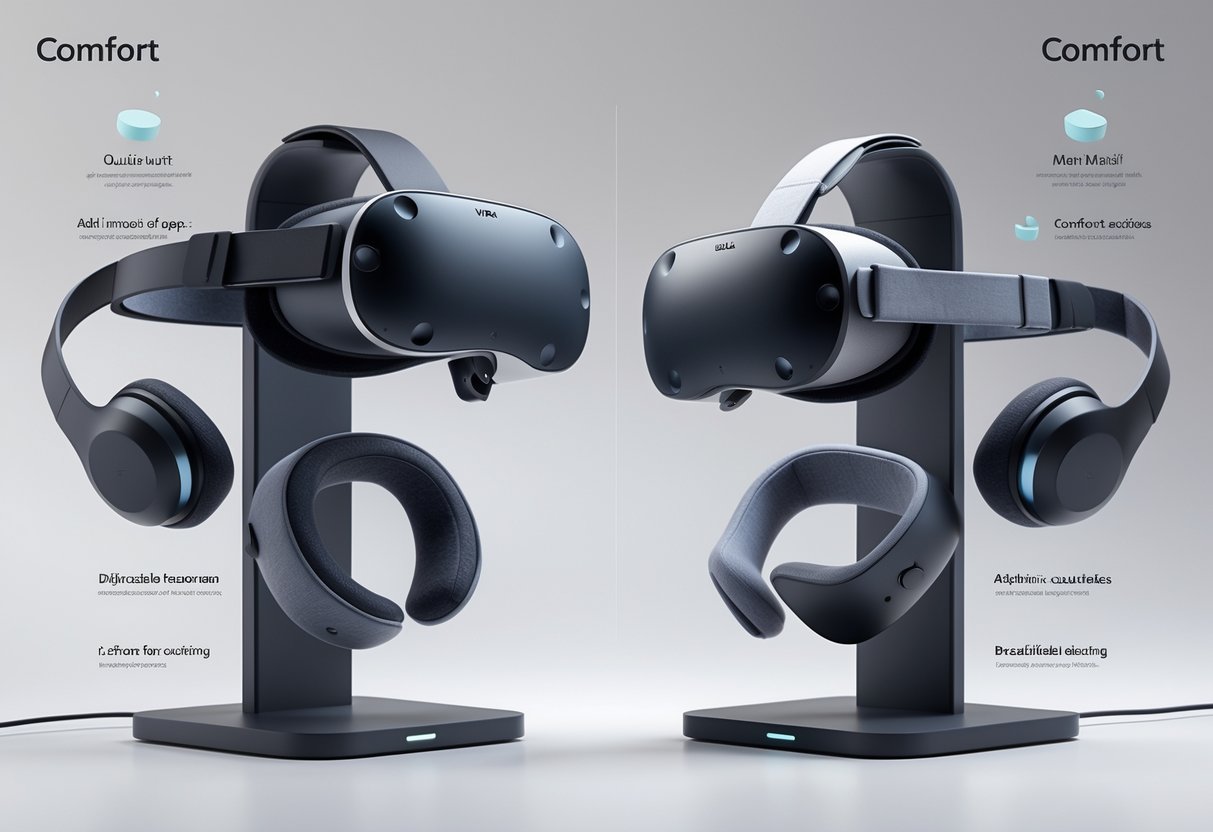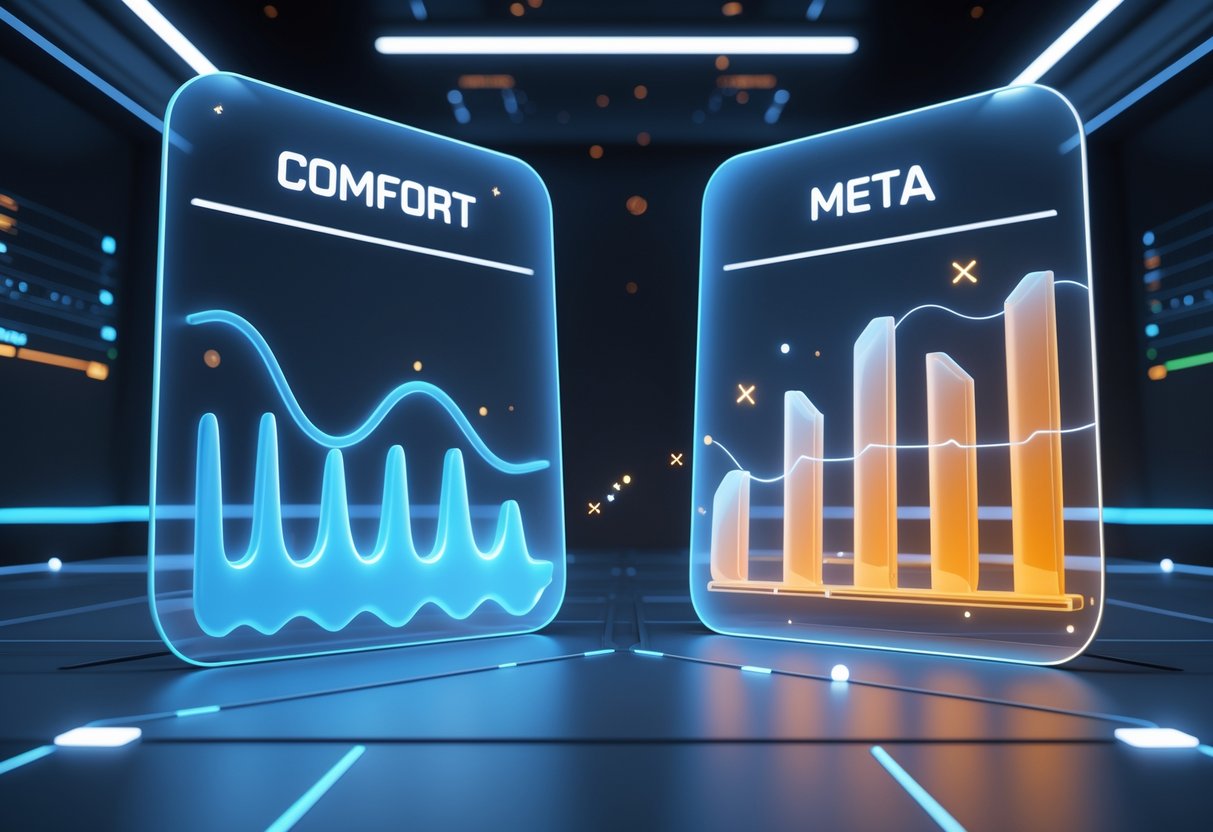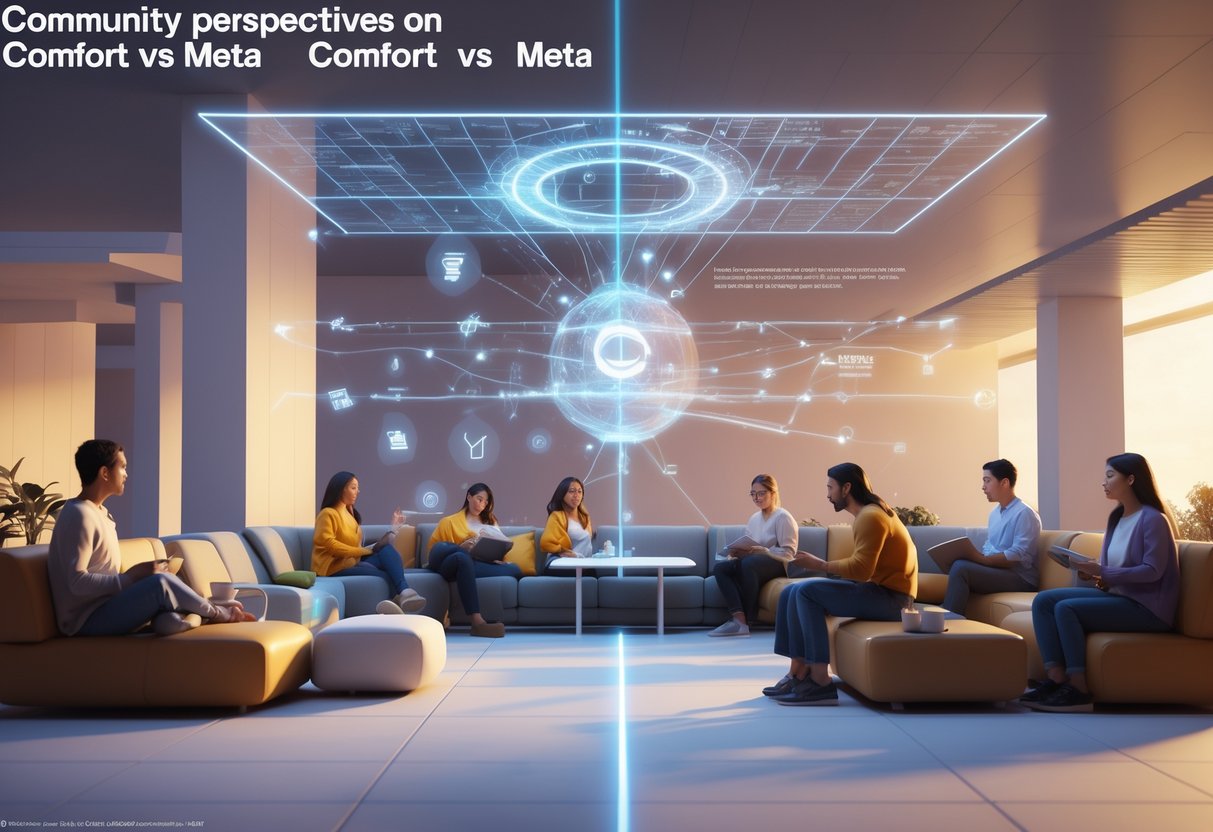Comfort vs Meta: Making the Right Choice in Gaming and VR
Updated On: October 26, 2025 by Aaron Connolly
Understanding Comfort vs Meta

Comfort picks are the champions or strategies we know inside and out. We can play them on autopilot, and they just feel right. On the flip side, meta means whatever’s currently ruling the competitive scene. These are the champs or tactics that everyone’s using because they’re just that strong.
This tension between comfort and meta shapes everything. It affects our ranked grind, and honestly, it even messes with how much fun we have.
What Is Comfort in Gaming and VR?
We call them comfort picks for a reason. They’re the champions we’ve poured hours into, the ones where every ability just clicks. We know the matchups, the power spikes, and all the little tricks.
Physical comfort matters too. If our VR headset pinches or our chair’s terrible, our play drops off fast. Good gear and a setup that doesn’t wreck our posture make a real difference over long sessions.
There’s also the mental side. When we play a champ we know, we stop thinking about the basics. Suddenly, we can focus on the big picture and make smarter calls.
Key comfort indicators include:
- Win rates above 55% over 50+ games
- Ability to carry even when behind
- Confidence in team fights
- Knowing power spikes without looking them up
People often underestimate comfort picks. They might seem dull compared to the hot new meta pick, but a player with 200 games on Ashe will usually stomp someone trying Aphelios for the first time.
Comfort picks shine when:
- Ranked pressure kicks in
- The meta champ is just too tricky to master fast
- Your team just needs someone steady to pump out damage
Defining Meta: Meaning and Evolution
The meta’s basically the “best right now” list. These are the champs with the highest win, pick, and ban rates in serious games.
Every patch shifts the meta. One little change and suddenly, a champ nobody cared about is must-pick material.
Current meta factors include:
- Win rates across all ranks
- Picks in pro tournaments
- How well champs fit with the popular team comps
- Counter-pick strength
We’ve all seen wild meta swings. Remember when Ezreal jungle went from troll pick to legit? A single buff to his Q scaling, and suddenly he was everywhere.
The meta doesn’t always show itself right after a patch. People need time to experiment and figure things out. Early adopters of new meta picks usually climb faster than those who wait for consensus.
Meta champs usually bring:
- High damage or utility
- Strong lanes
- Flexible builds
- Big team fight impact
If we get why a champ is meta, we can guess what’ll be strong next and adjust our champ pool before everyone else.
Where Comfort and Meta Overlap
The dream is when our comfort picks are also meta. That’s when we really start climbing.
Comfort meta picks give us both power and familiarity. We know their limits, and they’re strong in the patch. That’s a win-win.
Building a champ pool is about finding meta champs that actually fit how we like to play. For example, some ADC mains will always prefer Tristana over Draven, even if both are meta.
Priority for champ select:
- Comfort meta picks
- Comfort picks
- Counter picks
- Pure meta picks
Your target rank changes the balance. Below Platinum, comfort usually wins out. Execution just matters more than raw champ power at that level.
Heads up: Don’t ditch comfort for meta just because everyone else is. One-tricking a slightly off-meta champ beats fumbling through five meta picks you barely know.
Pros prove this. They stick to a handful of champs, not the flavor of the week.
The Impact of Comfort Picks
When we stick to comfort picks, we play better. We make smarter decisions and keep our performance steady. Players who chase meta without putting in the time usually can’t keep up.
Player Confidence and Consistency
Confidence changes everything. If we’re on a champ we know, we stop worrying about basic combos and start looking for big plays.
That mental shift? It’s huge. We don’t panic about missing skillshots or forgetting cooldowns. Instead, we can pay attention to the map and set up for team fights.
Consistency is our secret weapon. Our win rate evens out when we stick to a handful of champs instead of jumping around every patch.
Most players do better on champs they’ve played 50+ games with, meta or not. Familiarity just breeds consistency.
Team comms get clearer too. When we know our champ’s strengths and weaknesses, we can actually communicate them to teammates.
Skill Mastery and Familiarity
Knowing a champ inside out gives us small edges everywhere. We know our damage at every level, so our all-ins and escapes get sharper.
We start animation cancelling and comboing without thinking. All those little optimizations add up, especially against someone who’s still learning.
Matchup knowledge comes with reps. After enough games, we just know how to play out certain matchups.
Mechanical execution holds up under stress. Muscle memory takes care of the hard stuff, so our brain can focus on the bigger picture.
When a gank happens, we don’t freeze. Our hands just do the right thing.
Performance Under Pressure
Ranked nerves hit new champs harder. Trying to climb on someone you barely know? It’s rough.
Our comfort picks become our fallback when we’re on a losing streak. They help us reset and stop the tilt.
In clutch moments, experience beats meta. When the game’s on the line, knowing our limits matters more than having the “best” champ.
Most of our crazy comebacks happen on comfort picks, not meta ones. Familiarity lets us pull off creative plays and take smart risks.
Pressure exposes gaps fast. When things get tense, we default to what we’ve practiced most. Comfort picks just hold up better.
How Meta Influences Success

Going with the meta shapes competitive outcomes in a big way. Knowing when to follow or ignore trends can make or break your climb.
Advantages of Following the Meta
If you pick meta champs, you get an instant edge. Meta picks have the highest win rates because pros and analysts have already figured out the best builds, positioning, and team comps.
When you go meta, teammates instantly get what you want to do. Communication gets easier. Enemies also expect standard plays, which can make things predictable, but at least everyone knows the script.
Meta builds save us from endless experimenting. Instead of guessing at items, we can focus on playing better. For new players, that’s a lifesaver.
Quick win: Grab builds from op.gg or u.gg and you’ll see results fast.
Pros show meta works by winning tournaments. Watching them teaches us how to position, when to fight, and how to play as a team. These lessons transfer straight to ranked.
Risks of Blindly Adopting Meta
Meta gets predictable. People learn to counter it. Suddenly, off-meta picks catch teams off guard.
If we just copy meta without understanding why, we hit a wall when things change. Picking strong champs isn’t enough if we don’t know how to use them.
Popular champs get banned a lot. If we only play meta, we can get stuck with nothing. Having a deep champ pool keeps us flexible.
Heads up: Don’t just copy pro builds without thinking about your own skill or your team’s needs.
Some meta strats need serious teamwork. Pros practice together for months. Random solo queue teams? Not so much.
Keeping Up With Meta Shifts
Meta changes come from patches, tournaments, and player discoveries. Patch notes drop balance changes. Tournaments show us what works at the top.
How to track meta shifts:
- Patch notes and dev updates
- Pro picks and bans
- Streams and builds from high-elo players
- Community tier lists and discussions
Smart players don’t flip their whole pool every patch. They test new champs out in normals or practice tool before risking LP. That way, they don’t tank their rank during big changes.
Meta trends cycle. Aggressive picks might rule for a while, then suddenly defensive play comes back. If we spot these shifts early, we can get ahead instead of scrambling to catch up.
James Connolly, a gaming expert, says the best players “keep their core skills sharp but adjust their champ pool for what’s strong right now.”
Comfort vs Meta in Champion Selection
Picking between your tried-and-true champs and the meta favorites is a classic League of Legends dilemma. The real trick is finding a balance between your skill and the champ’s current power.
Balancing Champion Comfort and Meta Viability
Comfort picks are our bread and butter. We know their kits, their spikes, and their matchups like the back of our hand.
Meta champs are strong right now thanks to buffs or balance tweaks. They might have higher win rates or get snapped up in pro play.
James Connolly points out: “New players often struggle when they pick meta champions they can’t actually play well. Your skill with a champion matters more than tier lists.”
Here’s a quick comparison:
| Pick Type | Advantages | Disadvantages |
|---|---|---|
| Comfort Pick | • Know all combos and mechanics • Better decision making • Consistent performance |
• Might be weaker in current patch • Predictable for enemies |
| Meta Pick | • Statistically stronger • Better base stats/abilities • Favoured by current game state |
• Learning curve required • Might not suit your playstyle |
Mixing both is usually best. Learn 2-3 meta champs for your main role, but don’t forget your comfort picks.
If your comfort champ isn’t totally useless in the patch, just stick with them. A good player on a weaker champ often wins against someone floundering on a meta pick.
Counter Picks and Synergy
Counter picking sounds smart—until it isn’t.
Why counter picks flop:
- We barely know the counter champ
- We tunnel on lane and forget team fights
- The enemy’s just better on their champ, bad matchup or not
Team synergy matters more than counters. If our team needs CC and we go full damage just to counter, we’ve probably hurt the team more than helped.
Pick order should go like this:
- Comfort meta picks – Strong and familiar
- Comfort picks – The ones you always play well
- Counter picks – Only if you really know them
Always look at team comp first. Does your squad need a tank, damage, or CC? Pick for the team, not just your lane.
Quick tip: It’s usually smarter to avoid getting countered than to gamble on countering someone else. Safe, flexible champs often outperform risky counters.
Picking the Right Champion for You
Every game feels different, so picking the right champion depends on the situation. Let’s talk about when you might want to lean into each approach.
Go for comfort picks when:
- You’re playing ranked and the win really matters
- The enemy team hasn’t shown their picks yet
- You’re still learning the ropes and want to keep things simple
- Your go-to champ isn’t totally countered
Try meta picks when:
- You’re solid on a few champions and can swap easily
- You’re in a competitive setting
- The patch clearly favors certain champs
- You’re curious about new champs (but maybe stick to normals at first)
If you’re new, it’s honestly better to stick with 2-3 champs per role. Just get comfortable with them before stressing about the meta.
For folks who’ve played a while, start adding meta champs to your lineup. Try them out in normals before risking your rank.
Think about your rank too. In lower ranks, knowing your champ inside out usually beats chasing the meta. At higher ranks, both really start to matter since people can actually pull off meta strategies.
One thing—don’t just copy pro picks because you saw it in a tournament. Pro teams play a whole different game than solo queue.
You’ll probably do best with a small pool that mixes your comfort champs and a couple meta picks.
Comfort vs Meta in VR Headsets
Comfort in VR isn’t just about feeling good—it changes how long you want to play, and whether you’ll even enjoy it. Meta has tried to improve comfort with the Quest 3 over the Quest 2, but honestly, not everyone agrees it’s better.
How Comfort Impacts VR Sessions
If your headset isn’t comfy, even the best VR games get old fast. Heavy headsets make your neck ache in half an hour. Tight straps dig into your face.
Weight distribution really matters for longer sessions. If your headset pulls forward, your neck has to work overtime.
Face cushion design can make or break comfort. Hard cushions press into your cheeks, and bad airflow means you’ll sweat and fog up the lenses.
The strap system changes everything. Cheap elastic straps pile all the pressure into a few spots. Better straps spread the weight out.
Some common comfort annoyances:
- Headaches after half an hour
- Red marks where the headset sits
- Neck pain from all the front weight
- Glasses getting in the way
- Sweat pooling around your face
Meta’s Approach to Comfort in Design
Meta made the Quest 3 about 40% slimmer than the Quest 2. Less bulk brings the weight closer to your face, which helps balance—but also introduces new fit issues for some.
They switched to a pancake lens design to cut the thickness. It’s clever, but not everyone finds the new shape fits their face.
Meta also changed up the strap. The Quest 2 came with a basic elastic strap, while the Quest 3 expects you’ll want to buy extra accessories for peak comfort.
Face interface materials and ventilation got an upgrade. You’ll find multiple cushion sizes in the Quest 3 box.
They added a comfort rating system for games. Intense movement gets flagged, which helps folks avoid motion sickness.
It’s a trade-off: sleeker look, but maybe less comfy out of the box. Plenty of Quest 3 owners end up buying extra comfort gear to get back to Quest 2 levels.
Meta Quest 3 vs Previous Models
The Quest 3 brings some real comfort and usability upgrades over the Quest 2 and original Oculus. Meta focused on better weight balance, improved adjustability, and an easier setup.
Comparing Comfort Levels
The Quest 3 fixes a lot of the comfort issues that annoyed people with earlier headsets. Its weight sits more evenly, so you won’t feel it dragging your head forward as much.
We noticed the Quest 3’s strap spreads out the 515g weight better. The headset stays put even when you’re moving around a lot.
Notable comfort improvements:
- Softer, redesigned facial padding
- Weight balance that’s easier on your neck
- Slimmer shape means you bump controllers less
- Better airflow, less fog
With the Quest 2, you almost had to buy a pricey third-party strap for long sessions. The Quest 3’s default strap works for most folks right out of the box.
Lots of people got headaches after 30-45 minutes with the Quest 2. The Quest 3 usually lets you play for 90 minutes or more before you start to feel it.
Hardware Improvements
Meta gave the Quest 3 a serious hardware boost. The Snapdragon XR2 Gen 2 chip makes everything snappier.
Quick comparison:
| Feature | Quest 2 | Quest 3 |
|---|---|---|
| Resolution per eye | 1832 x 1920 | 2064 x 2208 |
| Refresh rate | 90Hz/120Hz | 90Hz/120Hz |
| RAM | 8GB | 8GB |
| Processor | XR2 Gen 1 | XR2 Gen 2 |
The pancake lenses look sharper across your whole field of view. Quest 2’s fresnel lenses left the edges blurry, so you had to keep your head moving.
Colour passthrough cameras make mixed reality actually usable, not just a weird extra.
The Quest 3 controllers ditched the tracking rings from the Quest 2. That means fewer broken rings and still solid tracking.
Ease of Use and Adjustability
Setting up the Quest 3 feels way faster. The new cameras map your room in a snap.
You get a smooth IPD slider from 53-75mm. Quest 2 only gave you three fixed options—pretty limiting.
Setup perks:
- Auto boundary detection
- Quicker Wi-Fi setup
- Easier app installs
- Improved hand tracking
The Quest 3 remembers multiple rooms and switches automatically. With the Quest 2, you had to redraw your play area every time.
Guardian setup uses the new colour cameras, so you actually see your room’s layout, not just a grainy outline.
Audio’s better too. The built-in speakers sound clearer, and you finally get a 3.5mm jack for wired headphones—no more adapters.
Evaluating Oculus Accessories for Comfort

Accessories can turn a so-so Quest 3 session into hours of pain-free gaming. Let’s check out the best comfort upgrades for straps, weight, and customisation.
Head Straps and Fit
The standard Quest 3 strap can dig in during long sessions. A lot of people feel discomfort after just 30-60 minutes.
Elite straps usually help the most. They spread out the weight and let you adjust the fit more precisely.
What to look for:
- Dial for easy adjustment
- Padded rear cradle
- Top strap for support
Third-party straps like the Kiwi Design Elite Strap go for £30-40. They’re often comfier than Meta’s own Elite Strap and cost less.
Straps with built-in batteries balance the headset and give you more playtime.
But, they do add weight. If you’ve got neck issues, try before you buy.
Weight Distribution Enhancements
The Quest 3 still feels front-heavy. At 515g, most of that weight sits at the front.
Adding 200-300g to the back really helps balance things out.
You can try:
- Battery packs (extra playtime and counterweight)
- Weighted pouches (about £10-15)
- DIY weights (just toss a small pouch on the back)
Halo straps change how the headset sits. They rest on your forehead, not your face.
People with sensitive skin usually love these. The downside? You might notice a small gap around your nose, which can break immersion a bit.
Customisation Options
Face cushions make a huge difference if you have sensitive skin. The default foam gets hot and can get itchy on long sessions.
Options:
- Silicone covers – Easy to clean, cool to the touch
- Leather – Feels premium and lasts
- Memory foam – Super soft and comfy
Honestly, silicone covers (£8-12) are a great place to start. They’re cheap, hygienic, and fix most issues.
Prescription lens adapters mean you can ditch your glasses in VR. That takes pressure off your nose and keeps your headset lenses scratch-free.
Brands like VR Optician sell Quest 3 adapters for £60-80. If you wear glasses a lot, it’s worth it.
Don’t forget about IPD adjustment. Quest 3 lets you set it anywhere from 58-71mm. Getting it right helps prevent eye strain and headaches.
Performance Metrics: Comfort vs Meta in Gameplay

Looking at performance data, you’ll see comfort-focused builds and meta builds play out pretty differently. Meta builds can win fast if you’re skilled, but they take more mechanical effort. Comfort builds bring steady progress and fewer wild swings in results.
Win Rates and Progression
Meta strategies give higher peak win rates for top players, but the average person sees big ups and downs. Data shows meta champs get 65-70% win rates in pro hands when the patch is right.
Comfort builds keep things more stable. Most players see 52-58% win rates, no matter their mechanics. That consistency helps you climb over time.
The main differences:
- Meta: High ceiling, but can crash hard
- Comfort: Decent ceiling, higher floor
- Learning curve: Meta takes 40-60 hours to master, comfort champs more like 15-25
Progression speed varies a lot. Meta players climb fast when they’re “on,” but can hit slumps. Comfort players just keep inching upward.
Statistical Trends
Tournament data shows some fun trends. Meta picks spike to 80-90% right after big patches.
But after about a month, comfort picks start creeping in. Things settle at around 60% meta, 40% comfort in most comps.
Performance swings are telling:
- Meta: ±15% win rate swings
- Comfort: ±8% swings
- Meta picks: 12% more volatile
VR esports put comfort front and center. Physical fatigue hits meta players harder. Long sessions drop meta performance by 20%, but only 8% for comfort builds.
Regions play differently too. European tournaments go for comfort builds about 45% of the time, while Asian regions stick to meta at 75%.
Examples From Top Players
Top players use both styles. James Connolly says: “The best competitors keep comfort builds in their back pocket for when meta picks fall apart under pressure.”
Tournament footage shows pros swapping to comfort picks mid-series. When the stakes are high, even top players fall back on what feels natural.
Some examples:
- Worlds finals: 3 out of 8 finalists used comfort picks in clutch games
- Regional qualifiers: Comfort builds popped up in 35% of matches
- Upsets: 60% of surprise wins came from comfort beating meta
Streamers see more viewer engagement when they break down comfort strategies. People just relate to them more.
Practice routines look different too. Meta specialists spend about 70% of their time drilling mechanics. Comfort-focused players spend 60% on decision-making and positioning.
The best pros master both and pick based on their opponent or the tournament—not just because “the meta says so.”
Psychological Effects of Comfort and Meta Choices

When you pick comfort choices in gaming, you actually cut down on mental strain and decision fatigue. Meta choices, even though they’re a bit more demanding, can really boost your motivation and sense of achievement when things go right.
Reducing Stress and Burnout
Research keeps showing that too many choices can be overwhelming. You see this in esports all the time—facing endless character builds or team comps can be a headache.
Comfort choices act as stress buffers. Picking your main or sticking with tried-and-true strategies gives your brain a break. You don’t have to process new info every second.
A meta analysis of 41 studies found that having some choice boosts motivation. But there’s a limit—too many options just overload you.
Quick win: Stick with 2-3 comfort picks for stressful matches. It really helps.
When you reduce cognitive load, a few things happen:
- Lower cortisol levels from familiar gameplay
- Less decision fatigue during long sessions
You also get better focus on execution, not just theory. And honestly, you’ll tilt less when things go sideways.
Pro players often use this trick. They go deep with a small champion pool instead of trying to master everything at once.
Boosting Enjoyment and Motivation
Meta choices hit our intrinsic motivation in a different way than comfort picks. When you pull off a meta strategy, you really feel that competence buzz.
Learning meta builds fires up your growth mindset. You’re not just coasting—you’re actually improving. That’s the kind of motivation that keeps people coming back.
The challenge-reward cycle looks like this:
- Spot the meta strategy (do some research)
- Practice execution (build skill)
- See results (hello, dopamine)
- Chase the next challenge (stay engaged)
Heads up: If you only chase meta, you might hit a wall if your skills can’t keep up.
Studies show moderate challenge levels feel best. Too easy? Boring. Too hard? Just frustrating.
A lot of semi-pros say their biggest gains came from mixing comfort picks with slow meta exploration. They kept what felt good, but still tried new stuff.
Community Perspectives on Comfort vs Meta

Gaming communities can’t quite agree whether you should stick with your favorites or chase the latest tier lists. If you look at online discussions, you’ll see that player rank, experience, and personal goals all shape what approach people take.
Opinions From the Gaming Community
You’ll find clear splits in the community based on skill and experience. Lower-ranked players usually benefit more from comfort picks—knowing your champ inside out often beats raw meta power.
A lot of experienced players have a kind of hierarchy. If your comfort pick is also meta, that’s best. Just comfort? Still good. Only meta with no practice? That’s rough.
Platinum-level players hit a crossroads. Mechanical skill alone doesn’t save you if your champ just isn’t strong enough. Meta comps start winning out when played right.
Streamers like Dyrus and BoxBox show comfort picks can work at high levels. Dyrus finds success with Sion, even when he’s off-meta. BoxBox carries with Riven, using builds like Black Cleaver and Titanic Hydra.
Most people agree that situational awareness matters most. Your comfort pick still needs to fit the team comp and what the game actually needs.
Influence of Online Discussions
Reddit and forums really shape how people think about champ selection. The top posts usually say that feeling comfortable beats playing something strong but awkward.
A lot of community advice is to learn meta champs until they become comfort picks. That way, you get the best of both worlds over time. You pick up the ins and outs of their kits just by playing.
But watch out: Online debates can get pretty black-and-white. Some posts ignore team comp or the actual match context.
Communities often recommend having three comfort champs per role. That gives you fallback options in champ select and beats always chasing the meta.
Forum threads remind us that meta is never fixed. Picks like Ezreal jungle went from “troll” to meta after a few patches. Attitudes shift fast as new strats prove themselves.
Future Trends: Comfort and Meta in Emerging Technologies

VR designers are finally listening to player feedback, and big platforms like Meta Quest are changing how comfortable gaming reaches the mainstream. It looks like user comfort will drive the next wave of innovation—about time, right?
The Role of User Feedback
Gaming companies now treat comfort feedback as gold. Meta, for example, collects thousands of user reports every day through Quest 3. People report everything from motion sickness to eye strain.
This feedback shapes hardware updates directly. The Quest 3, for example, got better weight balance after users complained about neck fatigue.
Top feedback areas changing things:
- Physical comfort: Headset weight, heat, fit tweaks
- Motion tolerance: Less nausea thanks to better tracking
- Visual clarity: Fixing blurry text and eye strain
- Control accessibility: Making hand tracking usable for everyone
Developers now make comfort rating systems, kind of like age ratings. Games warn you about motion intensity and offer comfort settings before you even start.
Beta testing isn’t just for bugs anymore. Companies pay testers just to report how their bodies feel during long sessions.
Anticipated Shifts in Game and VR Design
VR design is shifting to a “comfort-first” mindset. Instead of tacking on comfort features, devs now build games around what feels right for most people.
Physical design changes look like this:
| Design Element | Traditional Approach | Emerging Approach |
|---|---|---|
| Movement | Joystick locomotion | Teleportation and comfort zones |
| Menus | 3D floating interfaces | Simple 2D overlays |
| Game length | 60+ minute sessions | 15-30 minute bursts |
The Quest 3 uses mixed reality so you can see your real space while playing. That helps cut down on motion sickness.
Accessibility is finally going mainstream. New VR games launch with seated play, one-handed controls, and custom comfort settings.
We’ll probably see AI-powered comfort soon. Headsets could auto-tune your experience based on how you react physically, making a unique comfort profile for each person.
Frequently Asked Questions

Finding the right mix between comfort and meta approaches really helps explain why some designs focus on user wellbeing while others chase pure performance. Here are some practical questions and answers about each strategy.
What are the key differences between comfort-oriented designs and meta design principles?
Comfort-oriented designs put user wellbeing first. They focus on ergonomics, accessibility, and how easy something is to use long-term.
Meta design principles go for peak performance and efficiency. Sometimes, they sacrifice comfort to get the best possible results.
It all comes down to priorities. Comfort asks, “How does this feel?” Meta asks, “What gets the job done best?”
How can focusing on comfort improve the user experience in products?
Comfort-first designs reduce physical strain during long use. People can use products longer without getting tired or sore.
These designs make things less intimidating for new users. If something feels easy, people are way more likely to stick with it.
Comfort-focused products keep users coming back. If it feels good, you’ll keep using it.
In what ways might a meta approach influence the evolution of design standards?
Meta approaches push tech forward by chasing performance over comfort. That’s how you get big breakthroughs that eventually become the norm.
Pro users drive meta innovation. They’re willing to put up with discomfort if it means better results.
Eventually, these high-end features trickle down. What starts out pro-only often ends up in regular consumer products.
Can you balance comfort with a meta design strategy when creating a workspace?
Absolutely, you can. The best workspaces blend both. Start with comfort—think ergonomic chairs—then add meta features where they matter.
Go for adjustable furniture that lets you switch things up. That way, you get comfort for long sessions and flexibility for high-focus work.
The real trick is user choice. Give people the option to switch between comfort and performance as they need.
What are some examples where a comfort-first design has been critical to success?
Gaming controllers are a great example. The best ones focus on grip comfort and button placement, not just cramming in features.
Office chairs? Companies spend big on ergonomic designs because comfortable workers do better and miss less work.
Phones also lean hard into comfort. Manufacturers shape them to fit your hand, even if it means less space for internals.
How does the shift towards meta design trends affect customer expectations in terms of comfort?
Meta trends can really mess with what people expect when it comes to comfort. Folks notice all these high-performance features, but they still want things to feel easy and comfortable to use.
Professionals usually put up with some comfort issues. If a product delivers on performance, they’re willing to let less ergonomic designs slide.
On the other hand, regular consumers push back against pure meta designs. Most people just won’t give up comfort for features they don’t totally get or even want.

